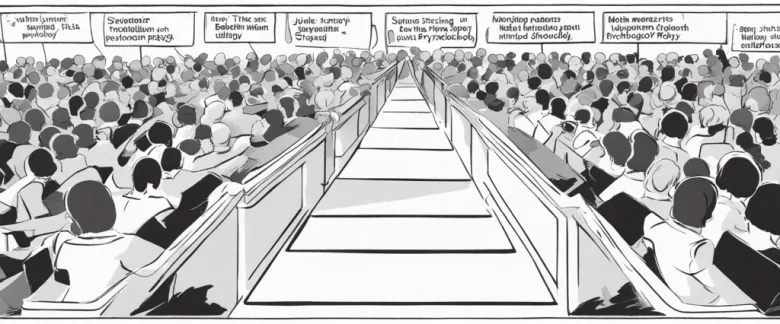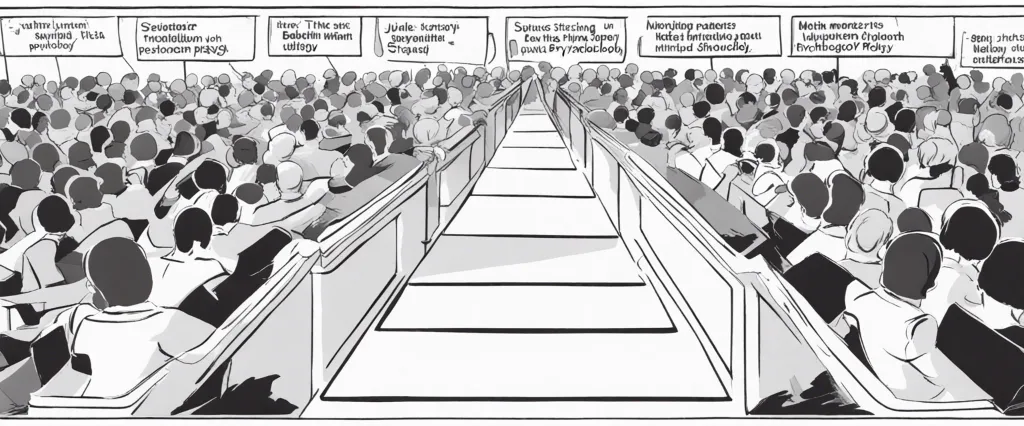In “How to Think Straight about Psychology,” Keith E. Stanovich guides readers through the intricacies of critical thinking within the realm of psychology. With a focus on debunking popular misconceptions, this book offers valuable insights into approaching the discipline with a clear and rational mindset. As a renowned psychologist and cognitive scientist, Keith E. Stanovich has dedicated his career to the study of human reasoning and decision-making processes. With numerous academic accolades, including a Professor Emeritus position at the University of Toronto, Stanovich brings his expertise and passion for promoting accurate thinking to the forefront of this thought-provoking guide.
Chapter 1: Introduction to Critical Thinking in Psychology
Chapter 1 of the book How to Think Straight about Psychology by Keith E. Stanovich serves as an introduction to the concept of critical thinking in the field of psychology.
The chapter begins by highlighting the importance of critical thinking in psychology, stating that it is an essential skill in understanding and evaluating the science of the mind. It emphasizes that being a critical thinker involves questioning preconceived notions, seeking evidence, and avoiding biases to achieve a more accurate understanding of psychological phenomena.
Stanovich introduces the concept of pseudoscience, which refers to claims that appear scientific but lack empirical evidence or fail to adhere to scientific principles. By identifying pseudoscience, critical thinkers can better differentiate between fact-based psychological research and unfounded beliefs or scams.
The chapter also discusses two modes of thinking: natural human intuition and reflective thinking. While intuition is a natural instinctual response to make quick judgments, it is often influenced by biases, emotions, and heuristics. Reflective thinking, on the other hand, requires a more systematic, logical, and evidence-based approach. Stanovich argues that critical thinking should be more reliant on reflective thinking rather than intuition alone.
Finally, the chapter addresses common misconceptions about psychology, such as the idea that it is merely common sense or that it is based solely on introspection. It emphasizes the scientific methodology employed in psychology and the importance of evidence-based research in this field.
In summary, Chapter 1 serves as an introductory overview of critical thinking in psychology. It emphasizes the need for a reflective approach to evaluating psychological claims, distinguishing pseudoscience from legitimate research, and dispelling misconceptions about the nature of psychology as a science.
Chapter 2: Understanding Psychological Research
Chapter 2 of “How to Think Straight about Psychology” by Keith E. Stanovich is titled “Understanding Psychological Research. In this chapter, Stanovich introduces readers to the fundamental principles of psychological research and how it contributes to the field of psychology.
The chapter begins by highlighting the importance of empirical evidence in psychology. Stanovich explains that the primary goal of psychological research is to understand and explain human behavior through systematic observation and experimentation. He emphasizes that relying solely on personal anecdotes, intuition, or testimonials is insufficient for acquiring reliable knowledge about psychology.
Stanovich then introduces readers to the scientific method, which is the systematic approach that psychologists use to investigate and understand psychological phenomena. He outlines the steps of the scientific method, including formulating a research question, developing hypotheses, conducting experiments, and analyzing data. Additionally, Stanovich emphasizes the significance of critical thinking in psychological research, as it helps to evaluate the validity and reliability of findings.
Next, the chapter discusses the importance of sampling in research. Stanovich explains how researchers use different sampling techniques to select participants for their studies and highlights the potential biases that can arise from inadequate sampling. He also introduces the concepts of random assignment and random selection and how they help in reducing bias and increasing the generalizability of research findings.
The chapter concludes by discussing the role of ethics in psychological research. Stanovich emphasizes the importance of ensuring the well-being and confidentiality of research participants and provides an overview of ethical guidelines that psychologists must adhere to when conducting studies. He also touches on the importance of rigorous research design, publication bias, and the replication of research findings for establishing robust scientific knowledge in psychology.
Overall, this chapter provides a comprehensive overview of the principles and methods of psychological research, highlighting its significance in acquiring trustworthy knowledge about human behavior. It encourages readers to think critically about psychological research findings and to recognize the importance of empirical evidence over personal anecdotes in understanding psychology.
Chapter 3: Sources of Psychological Knowledge
Chapter 3 of “How to Think Straight about Psychology” by Keith E. Stanovich delves into the sources of psychological knowledge and highlights the importance of understanding the scientific method for interpreting psychological claims.
Stanovich begins the chapter by emphasizing the need to evaluate scientific evidence critically in the field of psychology. He introduces the concept of pseudoscience, the practice of disguising non-scientific beliefs and ideas as scientific. The chapter focuses on distinguishing between pseudoscience and science by presenting the key features of a scientific theory, such as testability, empirical support, explanatory power, and falsifiability.
The author addresses the relevance of personal experiences, anecdotes, and case studies in generating scientific knowledge. While personal experiences are important, they do not represent rigorous scientific evidence. Stanovich stresses that the scientific method employs systematic observation, experimental control, and statistical analyses to provide a more reliable understanding of human behavior.
Next, the chapter explores the power of intuition, common sense, and authority as sources of knowledge. Although these sources might feel compelling, they often lead to misconceptions and biases. Stanovich argues that scientific evidence should override these subjective sources if we aim to develop a deeper understanding of psychological phenomena.
Stanovich further highlights the significance of empirical research published in peer-reviewed academic journals. These publications undergo rigorous scrutiny and evaluation by experts in the field, ensuring the integrity and validity of the research. He emphasizes that scientific consensus emerges from the accumulation of evidence, which helps build a foundation for reliable psychological knowledge.
In conclusion, Chapter 3 of “How to Think Straight about Psychology” underscores the importance of scientific methodology and empirical evidence as the most reliable sources of psychological knowledge. By understanding the scientific method and critically evaluating claims, readers can navigate through the abundance of pseudoscience and subjective influences to gain a more accurate understanding of psychology.
Chapter 4: Evaluating Psychological Claims

Chapter 4 of “How to Think Straight about Psychology” by Keith E. Stanovich focuses on the evaluation of psychological claims. The chapter provides readers with a detailed understanding of the importance of critical thinking when evaluating and interpreting psychological research and claims.
The chapter begins by emphasizing the need for skepticism in evaluating psychological claims. It highlights that many claims in psychology are based on weak evidence or flawed methodologies, making it essential for readers to approach them with a critical mindset.
Stanovich introduces the concept of pseudoscience and discusses its relevance in psychology. He explains that many pseudoscientific psychological claims lack proper scientific evidence and usually rely on anecdotes, testimonials, or personal opinions. In contrast, legitimate scientific claims are backed by systematic empirical research, peer review, and replication.
The author also explores the issue of correlation versus causation. He emphasizes the significance of understanding that correlation does not necessarily represent causation, outlining the need for controlled experiments to establish causal relationships.
Furthermore, Stanovich encourages readers to be cautious when interpreting psychological studies that are reported in the media. He explains that media outlets often oversimplify research findings, sensationalize results, or misrepresent the study’s limitations. Thus, he advises individuals to seek out credible sources and read beyond the headlines to obtain a more accurate understanding of the research.
Throughout the chapter, Stanovich stresses the importance of critical evaluation, empirical support, and scientific methodology when approaching psychological claims. He empowers readers to apply these principles in their thinking, enabling them to make informed judgments about psychological research and claims. By doing so, individuals can ensure that they are not easily influenced by pseudoscientific claims and instead develop a more rational and evidence-based understanding of psychology.
Chapter 5: Understanding Variability and Generalization
Chapter 5 of the book “How to Think Straight about Psychology” by Keith E. Stanovich is titled “Understanding Variability and Generalization.” In this chapter, the author explores the concept of variability, which refers to the differences and variations found among individuals within a given group.
Stanovich begins by discussing the dangers of relying on stereotypes and making blanket generalizations about individuals based on certain characteristics. He emphasizes that understanding variability is crucial in combating such biases. Variability, he explains, exists in every aspect of human behavior, cognition, and personality.
The author provides several examples to illustrate the importance of considering variability. For instance, he highlights research studies that examine the differences in cognitive abilities among individuals. These studies consistently find that there is more within-group variability than between-group variability. This means that the differences among individuals within a particular group are typically greater than the differences between different groups.
Stanovich also explains the concept of regression to the mean, which suggests that extreme performance in any given measure tends to move closer to the average over time. Understanding this concept is important to avoid misguided conclusions or unrealistic expectations.
Additionally, the chapter explores the issue of generalization, which refers to the extent to which findings from one population or sample can be applied to other populations or samples. Stanovich emphasizes that generalizations must be made cautiously, as the level of variability can differ across different groups or contexts.
Overall, Chapter 5 emphasizes the significance of recognizing and understanding variability to avoid stereotypes, make accurate generalizations, and think critically about the complexities of human behavior. It encourages readers to consider the individual differences within a group and approach generalizations cautiously, highlighting the importance of thinking straight and avoiding simplistic or biased reasoning.
Chapter 6: Causality and Correlation
Chapter 6 of “How to Think Straight about Psychology” by Keith E. Stanovich is titled “Causality and Correlation.” This chapter delves into the concepts of causality and correlation, which are essential in understanding how psychologists analyze data and draw conclusions.
Stanovich begins by discussing the distinction between causal claims and correlational claims. Causal claims suggest that one variable directly causes changes in another variable, whereas correlational claims only indicate a relationship between two variables without necessarily implying causation. The author emphasizes the importance of being cautious when attributing causality based on correlation alone.
Stanovich introduces the criterion for establishing causality developed by researcher David Hume. According to Hume’s criterion, three conditions must be met to establish causality: temporal precedence, covariation, and elimination of alternative explanations. Temporal precedence means that the cause must precede the effect in time, while covariation refers to the necessary correlation between the two variables. Elimination of alternative explanations involves ruling out other possible factors that could lead to the observed relationship.
The chapter goes on to highlight common mistakes made in inferring causality from correlation. One common error is the directionality problem, where it is unclear which variable is the cause and which is the effect. Another mistake is the third-variable problem, which occurs when an unmeasured factor may be influencing both the purported cause and effect.
Stanovich further demonstrates the importance of control groups in experimentation to establish causality. He discusses random assignment and the use of placebos as effective methods to control extraneous variables and isolate the true causal relationship.
Ultimately, this chapter emphasizes the need to critically evaluate studies and claims that involve causality and correlation. Understanding the difference between causation and correlation, as well as being aware of potential biases and experimental limitations, enables readers to think more accurately about psychological research and its implications.
Chapter 7: The Nature of Psychological Measurement
Chapter 7 of “How to Think Straight about Psychology” by Keith E. Stanovich is titled “The Nature of Psychological Measurement.” This chapter discusses the importance and challenges of quantifying psychological concepts, as well as the different methods used in psychological measurement.
Stanovich begins by emphasizing the need for measurement in psychological research and why it cannot solely rely on subjective judgments. He explains that quantification allows psychologists to make precise comparisons, test hypotheses, and establish cause-and-effect relationships. However, he also acknowledges that psychological constructs are often complex and abstract, making measuring them more challenging compared to physical quantities.
The chapter then delves into the different methods of psychological measurement. Stanovich introduces the distinction between self-reports, which rely on individuals’ introspection, and behavioral measures, which assess observable actions. He discusses the strengths and limitations of both methods, highlighting that self-reports can be influenced by biases and subjective interpretations, whereas behavioral measures might not fully capture the underlying psychological construct.
Stanovich further explores the concept of operational definitions, which are specific procedures used to measure a psychological construct. He emphasizes the importance of well-defined and reliable operational definitions, acknowledging that researchers need to choose appropriate measurements that align with their theoretical assumptions and research goals.
Furthermore, the chapter addresses the issue of reliability and validity in psychological measurement. Stanovich explains that reliability refers to the consistency and stability of measurement, while validity refers to whether the measurement actually assesses what it claims to measure. He stresses the importance of both concepts in ensuring accurate and meaningful psychological research.
In summary, Chapter 7 discusses the challenges and importance of measuring psychological constructs. It explores the different methods of measurement, such as self-reports and behavioral measures, and emphasizes the significance of well-defined operational definitions, reliability, and validity in psychological research.

Chapter 8: Applying Critical Thinking in Everyday Life
Chapter 8 of How to Think Straight about Psychology by Keith E. Stanovich focuses on the practical application of critical thinking skills in everyday life. The chapter starts by highlighting the importance of critical thinking as a tool for making informed decisions and avoiding cognitive biases.
Stanovich introduces the concept of belief perseverance, where people tend to cling to their initial beliefs even in the face of contradictory evidence. He emphasizes that overcoming this bias requires conscious effort and the willingness to challenge our own beliefs.
The chapter then explores the role of critical thinking in understanding and analyzing advertisements. Stanovich provides examples of misleading techniques commonly used by marketers, such as emotional appeals, celebrity endorsements, and statistical manipulation. By using critical thinking skills, individuals can discern the true intentions behind advertisements and make informed choices.
Another topic covered in this chapter is the application of critical thinking to news media. Stanovich cautions against relying on a single source of information and emphasizes the importance of seeking multiple perspectives, fact-checking, and being skeptical of overgeneralizations or sensationalism.
Furthermore, the chapter discusses everyday life situations where critical thinking is crucial, such as evaluating the credibility of sources, making financial decisions, and assessing health-related claims. Stanovich provides practical tips and strategies to improve critical thinking skills in each of these contexts.
In conclusion, Chapter 8 of How to Think Straight about Psychology delves into the practical application of critical thinking skills in everyday life. It highlights the significance of questioning one’s own beliefs, understanding marketing techniques, critically analyzing news media, and using critical thinking in various decision-making scenarios. By incorporating these skills, individuals can navigate the complexities of modern life more effectively and make more informed choices.
After Reading
In conclusion, “How to Think Straight About Psychology” by Keith E. Stanovich is a thought-provoking and insightful book that aims to equip readers with the essential tools to critically evaluate psychological claims and research. Stanovich emphasizes the importance of skepticism, logical reasoning, and scientific literacy in navigating the complex field of psychology. Through engaging examples and practical exercises, he encourages readers to question popular misconceptions, biases, and fallacies frequently found in psychological literature and the media. By promoting a scientific and evidence-based approach to thinking, the book empowers readers to make more informed judgments about psychological theories and research, ultimately fostering a more accurate and deep understanding of human behavior and cognition.
1. Thinking, Fast and Slow” by Daniel Kahneman: This book delves into the two systems that drive the way we think: the fast, intuitive, and emotional system, and the slow, deliberate, and logical system. Kahneman explores the biases and errors that often occur in decision-making and offers insights into how we can enhance our thinking abilities.
2. Predictably Irrational” by Dan Ariely: Ariely, a behavioral economist, presents a fascinating exploration of human irrationality. Through a series of clever experiments, he reveals how our decisions are often influenced by seemingly insignificant factors and provides insights into why we are prone to making predictable mistakes.
3. Nudge: Improving Decisions About Health, Wealth, and Happiness” by Richard H. Thaler and Cass R. Sunstein: Thaler and Sunstein introduce the concept of “nudge,” which focuses on designing choices in a way that encourages positive decision-making. By understanding the psychology behind our choices, they propose strategies to nudge individuals towards better outcomes, both on a personal and societal level.
4. Influence: The Psychology of Persuasion” by Robert B. Cialdini: Cialdini explores the techniques and principles behind persuasion and influence. Through engaging anecdotes and scientific research, he uncovers the secrets behind compliance, social proof, and other psychological tactics that shape our decisions.
5. The Art of Thinking Clearly” by Rolf Dobelli: Dobelli uncovers logical fallacies and cognitive biases that cloud our thinking and decision-making. In this collection of brief essays, he exposes common errors and provides tips to overcome them, offering a practical approach to cultivating clearer thinking.




